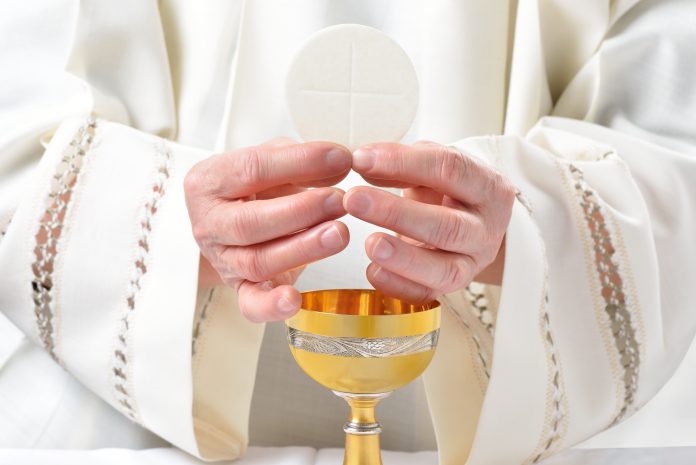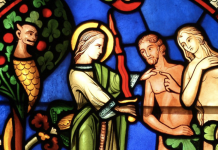
by Jeanne Heiberg
Who doesn’t like food? Most of us enjoy three meals plus snacks each day. In fact, many of us have to be careful about how much we eat to be sure we maintain a healthy weight and diet.
We need food and we enjoy the taste of food—all kinds.
Jesus Feeds the Multitudes
Jesus knew this when he fed 5,000 men and their families stranded in the hills of Judea. Rather than send the people away to find food on their own, he increased five loaves and two fish so that there was enough to feed everyone. There were even 12 baskets of leftovers.
This event is so significant that all four Evangelists include it in their Gospels (Matthew 14:13-21; Mark 6:31-44; Luke 9:10-17; John 6:5-15). My favorite account is the one we find in John’s Gospel because it is of a child, like your students, who provides the loaves and fish with his eucharistic generosity.
The Gospels tell us that Jesus blesses this small amount of food and gives it to the disciples to distribute. When the huge crowd has eaten, Jesus tells his disciples to gather the remnants—and they fill 12 baskets. Jesus is the master of abundance and values the gifts of God; Jesus doesn’t waste.
This is an important story because it prefigures (which means to show or suggest ahead of time) the Last Supper and the Eucharist. Through the centuries, Jesus has continued to feed multitudes with abundant food for the body and the soul. He feeds us today.
Jesus is fully present to us in the Eucharist; he gives himself to us in abundance. If we are open to him—if we allow ourselves to be nourished by him in body, mind, and heart—he gives to the world abundantly in and through us.
Sharing God’s Abundance
Some see the incident of the feeding of the multitude that we read about in the Gospels being prefigured in the Old Testament. In Exodus 16, for example, the Israelites eat manna in the desert—bread from heaven that God provided.
Because God is so generous, we, in turn, are to be generous, and we are blessed when we share. God is pleased with our fasting that includes “sharing your bread with the hungry” (Isaiah 58:7). A person is virtuous if he or she “gives food to the hungry” (Ezekiel 18:7). The kindly person will be blessed because he “gives of his sustenance to the poor” (Proverbs 22:9).
In the New Testament, St. Paul continues the promise of blessings for those who are generous. “Those who sow sparingly will reap sparingly” while “those who sow bountifully will reap bountifully…God loves a cheerful giver…God is able to make every grace abundant for you, so that in all things, always having all you need, you may have an abundance for every good work” (2 Corinthians 9:6, 8).
A Generous Measure
Jesus blesses the Church and the world with a generous spirit of giving and sharing. He says, “Give and gifts will be given to you; a good measure, packed together, shaken down, and overflowing, will be poured into your lap. For the measure with which you measure will in return be measured out to you” (Luke 6:38). A measure so given is generous, abundant, and touches the heart of the one who gives and the one who receives.
Say to the Children
Jesus was surrounded by 5,000 people who followed him to hear his wonderful words of life. When the people were filled with his inspiring words, the disciples told Jesus to send the people away so they could find food. The disciples were astonished when Jesus told them they were to feed this huge group themselves.
In one of the Gospel accounts of this incident in Jesus’ life, it was a boy—perhaps around your age—who shared the food he had. Jesus took the boy’s five loaves and two fish, gave them to his disciples, and told them to feed the crowd. This seemed impossible. Yet, this small amount of food fed a crowd of over 5,000 people. Not only that! There were 12 baskets of food left over. This event is called the Multiplication of the Loaves.
Perhaps the young boy who had the five loaves and two fish was taking the food home to his family. Or perhaps he was with his family in the group that was listening to what Jesus taught. Maybe the food he had was his lunch. We don’t know anything about him except that he had the food—and the little bit of food he had became enough food to feed over 5,000 people. That’s a miracle.
Studies have shown that when people receive from the generosity of others, they likely will share what they have as well. Their hearts are touched with the goodness of others, and they realize how important it is to reach out to others. It’s like a row of dominoes balanced on end, one right next to the other. When just one domino falls over, all the others fall as well. The goodness of sharing is the same way. The first act of sharing leads to another act of sharing that leads to another act of sharing and so on.
Other studies have shown that sharing makes us happier and healthier people. We don’t cling to what we have in fear of not having enough for ourselves. Rather, we trust in God’s abundant goodness, share what we have with others, and experience a very special kind of joy that is hard to describe.
Our abundant God honored the boy who had the five loaves of bread and two fish; the boy has been remembered for 2,000 years, coming to mind every time we read this part of the Gospel according to John. When we are generous, God can expand the results of our goodness far beyond anything we can imagine. We might be limited in many ways, but there are no limits with God.
Imagine this example: To get water from the ocean, we can use a thimble or a bucket or a tank truck. We can scoop or dip or haul and scoop or dip or haul for a very long time, but we’ll never empty the ocean. The ocean is like God’s abundance. We can receive from God’s abundance—a little bit or a great amount, according to how open and ready we are to receive—and yet God’s abundance is never lessened. (Share content from the article above, especially the words of St. Paul and Jesus.)
This miracle of the loaves prefigured (which means to show or suggest ahead of time) the bread of life, the bread of heaven that Jesus gave to his Apostles at the Last Supper and that he now gives to us at every Mass. The miracle is that Jesus himself is present to us.
But it is not only the bread that is transformed; we who receive Jesus in the Eucharist are also transformed by the presence of Jesus around us and in us. That is an even greater miracle. Through this miracle, God transforms the hearts and minds of all those who are open to accepting him, making this a better world with an abundance of peace, love, and joy. Through this miracle, God gathers together people of faith who will live with Jesus in heaven forever.
Let’s make banners that celebrate the miracle of the loaves and fish. These banners will remind us of the young boy’s eucharistic generosity and our call to share with others whenever we can and whatever we have. They will inspire us to acts of generosity in our own lives.
ACTIVITY: Loaves and Fishes Craft
MATERIALS
* 5” x 7” or 9” x 12” pieces of felt, craft foam, or construction paper (for the background, one for each banner)
* small pieces of felt, craft foam, or construction paper in bright and contrasting colors (for the loaves and fish and/or the figures of the boy and Jesus)
* scissors
* glue stick
* patterns [CLICK HERE] (or have students make their own patterns)
PROCEDURE
1. Trace patterns of loaves and fish (and/or the boy and Jesus) on small pieces of felt, craft foam, or construction paper. Cut them out.
2. Arrange loaves and fish (and/or the boy and Jesus) on the background piece.
3. Glue pieces in place and let dry.
4. Add hanging loop to the top and a decorative trim at the bottom. (Sewing these pieces in place is best but gluing will work.)
Option: If students choose to use the figures of the child and Jesus, they may want to add details to the child figure that create likenesses of themselves.
Loaves and Fish Prayer
Plan ahead for this prayer. Have children bring in loaves of bread (whole grain is best) or non-perishable food items. These items represent our longing to be open to receive from Jesus and to share with others. Hang the banners around the prayer table. Also place a plant or flowers on the prayer table, along with a Bible with the readings marked (see Readings below).
Opening Song: “Bread for the World” © 1990 Bernadette Farrell, found in Spirit & Song 1 & 2 Song Text and Prayers. OCP
Opening Prayer: Loving Creator, Source of All Good, thank you for sending Jesus to teach us how to live in your abundance—generously receiving from you and giving to others. Help us to be aware of his loving presence in Holy Communion and to allow ourselves to be transformed into his presence in the world.
All: Amen.
Readings: Isaiah 58:7 (sharing bread with those who are hungry); Proverbs 22:9 (give sustenance to those who are poor); 2 Corinthians 9:6-10 (sow bountifully, reap bountifully); John 6:5-15 (the multiplication of the loaves)
Commentary: Many people refer to God as the Source of All Our Good—of everything, including you and me.
To show how grateful we are to God for all he gives us, and to express our readiness to share with others, let us place an item on the prayer table that that we can share with those who do not have enough to eat. Let the little boy who was so generous with his food inspire us to go beyond our limits in generosity, love, and faith in Jesus’ presence to us always. (Invite each child to come forward to place his or her “gift” on the prayer table.)
Closing Blessing and Prayer: Generous Father in Heaven, thank you for all you give us to feed our bodies, minds, and hearts. Bless these banners we have made. May they remind us of your abundant goodness—that you are ready to give us all we need. Fill us with a generous spirit so that we may cheerfully and freely give to others, as the boy gave his food to Jesus.
All: Amen.
Closing Song: “Eat This Bread.” Jacques Berthie. Text John 6, adapted by Robert Bastini © 1984, 1984, 1985 Ateliers de Taize France. GIA Publications
Jeanne Heiberg is the author of Advent Arts and Christmas Crafts (Paulist Press) and Advent calendars (Creative Communications). She has taught art, writing, creative catechetics, and meditation, and has directed parish catechetical programs. Jeanne writes, paints, and gives writing workshops in upstate New York.
Copyright 2011, Bayard, Inc. All rights reserved. This article is protected by United States copyright and other intellectual property laws and may not be reproduced, rewritten, distributed, redisseminated, transmitted, displayed, published or broadcast, directly or indirectly, in any medium without the prior written permission of Bayard, Inc.
This article was written by the Catechist Staff and appeared in Catechist magazine, December 2010.
Image Credit: Shutter Stock 392338087




